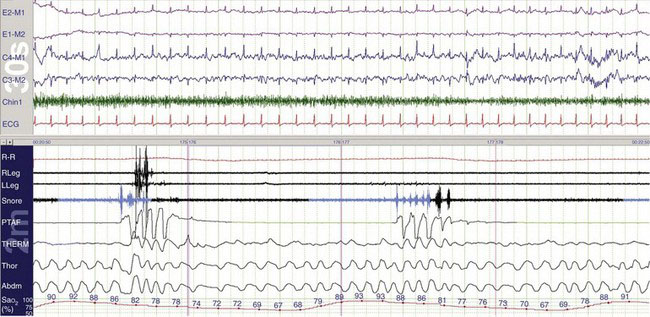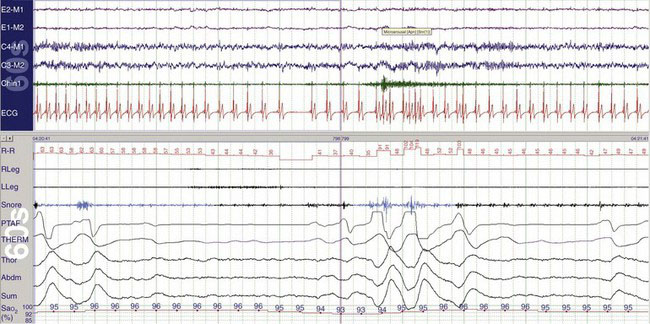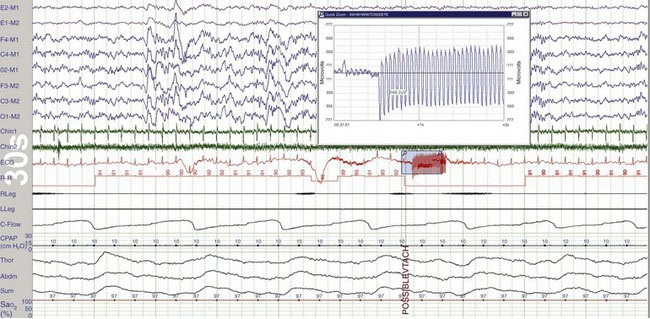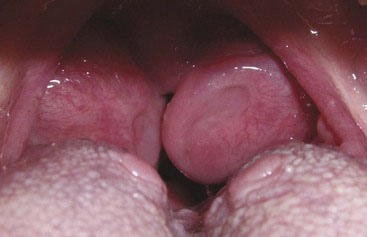Section 10 Sleep-Related Breathing Disorders
A 38-Year-Old Man with a History of Scrotal Edema
The patient is a 38-year-old real estate agent who presents in mid-January with a 15-year history of snoring, a 2-year history of witnessed apnea, and excessive daytime sleepiness. The patient has an Epworth Sleepiness Scale score of 17. Twelve months previously the patient started to notice swelling of his feet and ankles, and during the course of the year he developed severe edema, which peaked on New Year’s Eve when his edema was so severe that it resulted in swelling of his testicles and legs. He was admitted to the hospital and was told that he had heart failure. He was treated with heart failure medications, and he lost 60 pounds by the time of discharge, 1 week later. He was sent for a sleep evaluation immediately after discharge. A fragment from his sleep study is shown in Figure 10.1–1. The top window is a 30-second epoch, the bottom is a 2-minute epoch.
Frantic Call from the Sleep Tech
A 48-year-old patient, complaining of snoring and daytime sleepiness, is in the sleep laboratory having overnight polysomnography. He is on oxycodone for pain. The night tech phones the on-call doctor with concerns that the patient is having a dysrhythmia “issue” and he does not know how to proceed. The tech captures the PSG screen and sends the image file to the on-call doctor by e-mail. The PSG fragment in Figure 10.1–3 shows a 60-second epoch.
A 67-year-old female patient with a BMI of 29 has a history of snoring and insomnia. She is in the hospital for a minor elective orthopedic procedure. In the postanesthesia area she is noted to snore loudly. The surgeon orders a sleep test consisting only of oximetry, which is done by the respiratory therapy department and is interpreted by a pulmonologist who interprets such tests for a company doing home testing. He interprets the test as consistent with mild sleep apnea and prescribes a nasal mask and an autotitrating CPAP machine (pressure range 5-10 cm H2O). The patient was sent home with such a machine, but now she is more fatigued than before and can’t fall asleep on the CPAP. She is then referred to a sleep clinic by her family doctor for a second opinion. She brings in the recording shown in Figure 10.1–4.
Obstructive Apnea Comorbidities
Not Just Middle-Aged Obese Men
Summary
Must Read
 AASM Manual for the Scoring of Sleep and Associated Events: Rules, Terminology, and Technical Specifications, pp 45-49.
AASM Manual for the Scoring of Sleep and Associated Events: Rules, Terminology, and Technical Specifications, pp 45-49.Epidemiology
 Adults
Adults The syndrome is present when there are 5 or more abnormal obstructed breathing events and sleepiness.
The syndrome is present when there are 5 or more abnormal obstructed breathing events and sleepiness.Pathophysiology
Diagnostic Methods
 Polysomnography for sleep breathing disorders: scoring rules for adults (Atlas, p 269; Manual, pp 45-47)
Polysomnography for sleep breathing disorders: scoring rules for adults (Atlas, p 269; Manual, pp 45-47) Hypopnea
Hypopnea
































































